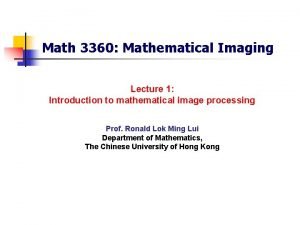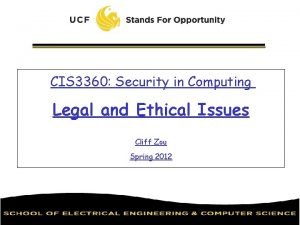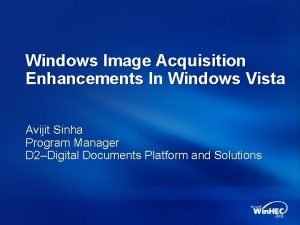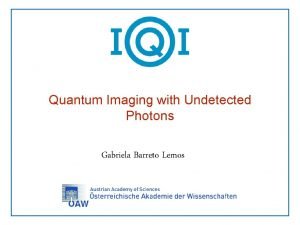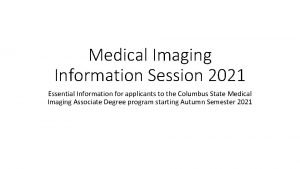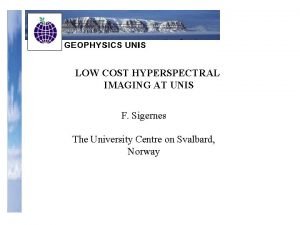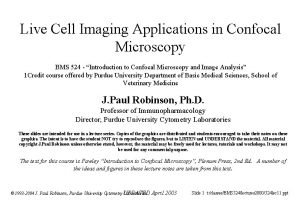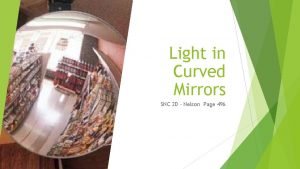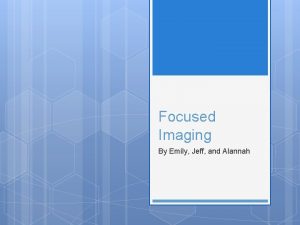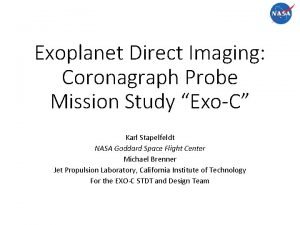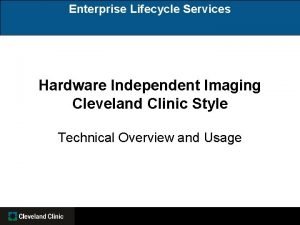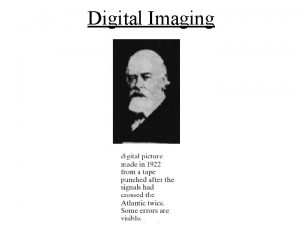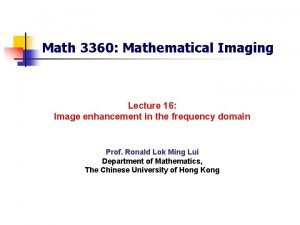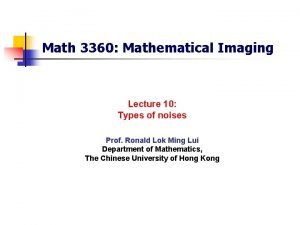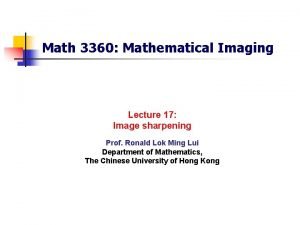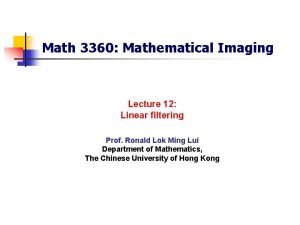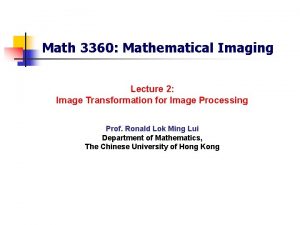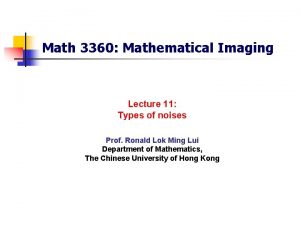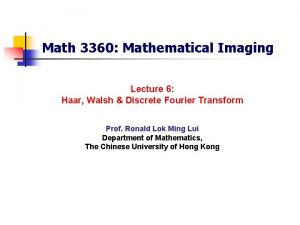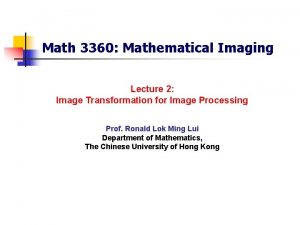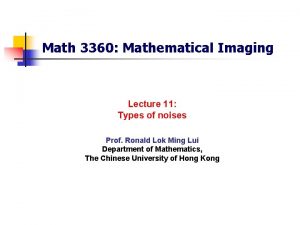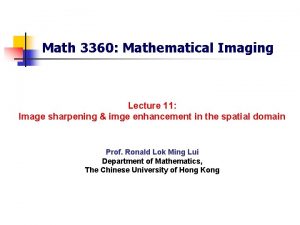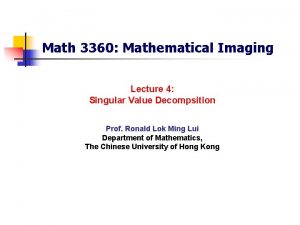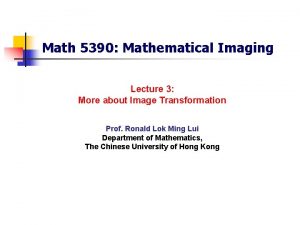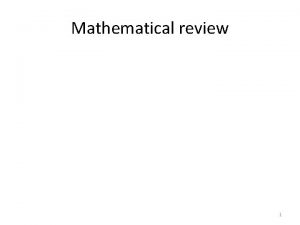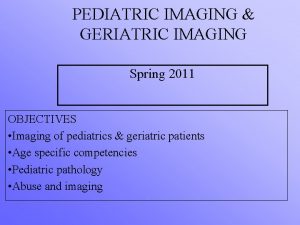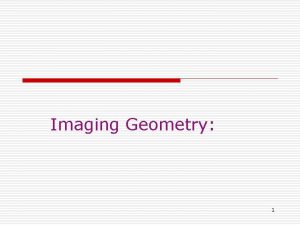Math 3360 Mathematical Imaging Lecture 1 Introduction to
























- Slides: 24

Math 3360: Mathematical Imaging Lecture 1: Introduction to mathematical image processing Prof. Ronald Lok Ming Lui Department of Mathematics, The Chinese University of Hong Kong

Some Useful Information n n n n Lecturer: Prof. Ronald Lui Email: lmlui@math. cuhk. edu. hk Tel: 3943 -7975 Office: Lady Shaw Building (LSB) 207 Lecture time (? ): Mon 8: 30 am-10: 15 am; Fri 9: 30 am-10: 15 am (How about: Mon 8: 45 am-10: 15 am? ) Textbook: Will be based on ppt, lecture notes uploaded on the course website Course website: http: //www. math. cuhk. edu. hk/~lmlui/Math 3360. html Other references: n n n Image processing: the fundamentals by Maria Petrou and Costas Petrou [Free access of online version on CUHK library] Fundamentals of Digital Image Processing: A Practical Approach with Examples in Matlab by Chris Solomon and Toby Breckon [Free access of online version on CUHK library] Digital Image Processing (3 rd ed. ) by Rafael C. Gonzalez and Richard E. Woods [Available in CUHK bookstore]

Some Useful Information n Assessment scheme: n Homework assignment (written and programming) 15% [Programming homeworks will only require basic Matlab programming skills. The usage of Matlab will also be discussed as they are used. The aim is to let students appreciate and enjoy the importance of mathematics in imaging through actual (simple) implementation. ] n n n Midterm 35% Final 50% Midterm + Final will be based on homework + pool of practice exercises Incline to give good grades to as many students as possible! Relax + enjoy + arouse interest in imaging! Good students should be able to work on a research project on imaging with me (if interested).

What is our goal in Math 3360? n Mathematical + Image Processing IMAGE PROCESSING TASKS: Denoising, Segmentation, Registration, Compression, … MATHEMATICS: Linear algebra, Calculus, transformation, …

What is our goal in Math 3360? n Topic to be covered: n n n Introduction to digital images and imaging geometry; Image transformations: DFT, DST, SVD etc; Image compression; Statistical description of images; Image enhancement and Image restoration; Image segmentation and edge detection

Some tastes about IMAGING n Image denoising: n n Image can be corrupted by “noises” during transmission or error during capturing the image intensity Reconstruct a “clean” (usually visually) image from the noisy one

Some tastes about IMAGING n Image denoising: n Where is the MATHEMATICS? Minimization model: n Solving PDE: n Don’t worry about the mathematics! You will learn it (simple version) and find it easy later!

Some tastes about IMAGING n Image segmentation: n n n Image may contain too much information. Need: extract useful information from an image. Image segmentation aims to automatically extract important part or regions of an image.

Some tastes about IMAGING n Image segmentation: n n Where is the Mathematics? Minimization model: Don’t worry about the mathematics! You *may* learn it (simple version)!

Some tastes about IMAGING n Image compression: n n Image compression aims to use less storage to represent an image. Do you know familiar JPEG compression is actually based on mathematical theories? You will learn how it works in Math 3360.

What is a digital image? n Mathematical definition: n n n A 2 D (grayscale) digital image is a 2 D function defined on a 2 D domain (usually rectangular domain): is called the brightness/intensity/grey level; (x, y) is the spatial coordinates of the image. Thus, a 2 D digital image looks like this: Each element in the matrix is called pixel (picture element); Usually, and IMAGE PROCESSING IS RELATED TO LINEAR ALGEBRA!!

What is a digital image? n Mathematical definition of color image: n n n A 2 D (color) digital image is a 2 D function defined on a 2 D domain (usually rectangular domain): are the intensity/brightness/grey level corresponding to R, G and B respectively ; Combination of R, G, B forms the full spectrum of color! WE WILL FOCUS ON: Grayscale image!

How is a digital image formed? n Sensor: n n n Each sensor captured the amount of photon of certain wavelength; Typical color images consist of three color bands (RGB). Reflected light of an object/phontons are captured by three different sets of sensors, each set made to have a different sensitivity function. Figure 1: The spectrum of the light which reaches a sensor is multiplied with the sensitivity function of the sensor and recorded by the sensor. This recorded value is the brightness ofthe image in the location of the sensor and in the band of the sensor. This figure shows thesensitivity curves of three different sensor types.

How is a digital image formed? n Example 1: n n n A digital camera has a triple array of 3 x 3 sensors: The wavelengths of the photons that reach the pixel locations of each triple sensor: Sensitivity of the sensor:

How is a digital image formed? n Example 1. 1: (Continued) n Intensity:

What is “Image resolution”? n Image resolution: n Recall: A digital image looks like: where: n n (N, G) is called the image resolution. Sometimes, (n, m) is referred to as image resolution as well.

Image resolution rescaling n Example 1. 2: (Convert an image to the prescribed digital band) n Divide the range of value into 8 bands: n We get:

What is “Image resolution”? n Effect on different image resolution: n Checkerboard effect: reducing N

What is “Image resolution”? n Effect on different image resolution: n False contouring: reducing M

What is “Image resolution”? n Little Effect by m on a complicated image:

What is “Image contrast”? n Good image contrast means: n n grey values present in the image range from black to white; making use of the full range of brightness to which the human vision system is sensitive.

What is “Image contrast”? n Normalization to get good image contrast Example 1. 3: n Measured intensity: n Divide according to the min and max of intensity: n

What is “Image contrast”? n Normalization to get good image contrast Example 1. 3: n Final result after normalization: n Compare with: n

How do we read a digital image in Matlab? n n Keep in mind: imread & imwrite! Please attend TA session when you will learn MATLAB command to do mathematical imaging!
 Math3360
Math3360 Frc driver station mac
Frc driver station mac Cis 3360
Cis 3360 Cis 3360 ucf
Cis 3360 ucf Cis 3360
Cis 3360 Cis 3360
Cis 3360 Mathematical economics vs non mathematical economics
Mathematical economics vs non mathematical economics 01:640:244 lecture notes - lecture 15: plat, idah, farad
01:640:244 lecture notes - lecture 15: plat, idah, farad Introduction and mathematical concepts
Introduction and mathematical concepts Introduction and mathematical concepts
Introduction and mathematical concepts Introduction to biochemistry lecture notes
Introduction to biochemistry lecture notes Introduction to psychology lecture
Introduction to psychology lecture Introduction to algorithms lecture notes
Introduction to algorithms lecture notes Math game math hit the button
Math game math hit the button Windows image aquisition
Windows image aquisition Quantum imaging with undetected photons
Quantum imaging with undetected photons Cscc medical imaging
Cscc medical imaging Affordable hyperspectral imaging
Affordable hyperspectral imaging Live cell imaging ppt
Live cell imaging ppt Curved mirrors worksheet
Curved mirrors worksheet Focused imaging learning
Focused imaging learning Direct imaging subsystem
Direct imaging subsystem Hardware agnostic imaging
Hardware agnostic imaging Digital images definition
Digital images definition Digital imaging artist
Digital imaging artist
